Page 221 of 338
When you put the cap back on, turn it to the right until
you hear at least three clicks.
I NOTICE:
If you need a new cap, be sure to get the right
type. Your dealer
can get one for you. If you get
the wrong type, it may not fit or have proper
venting, and your
fuel tank and emissions system
might be damaged.
6-8
ProCarManuals.com
Page 222 of 338
Fuel Door NIanual Release
If your vehicle has a fuel
door lock, the fuel door can
be opened manually in case
of
an electrical power
failure.
Open the trunk, the release mechanism is
on the driver’s
side
of the vehicle, at the top of the trunk compartment.
Pull the tab rearward to release the fuel door.
NOTICE:
Prying on a locked fuel filler door can damage it.
Use the remote fuel door manual release located
in the trunk.
--
Checking Things Under the Hood
The following information tells you how to check fluids,
lubricants and important parts under the hood.
To open the hood, first pull the hood release handle
inside the vehicle.
ProCarManuals.com
Page 224 of 338
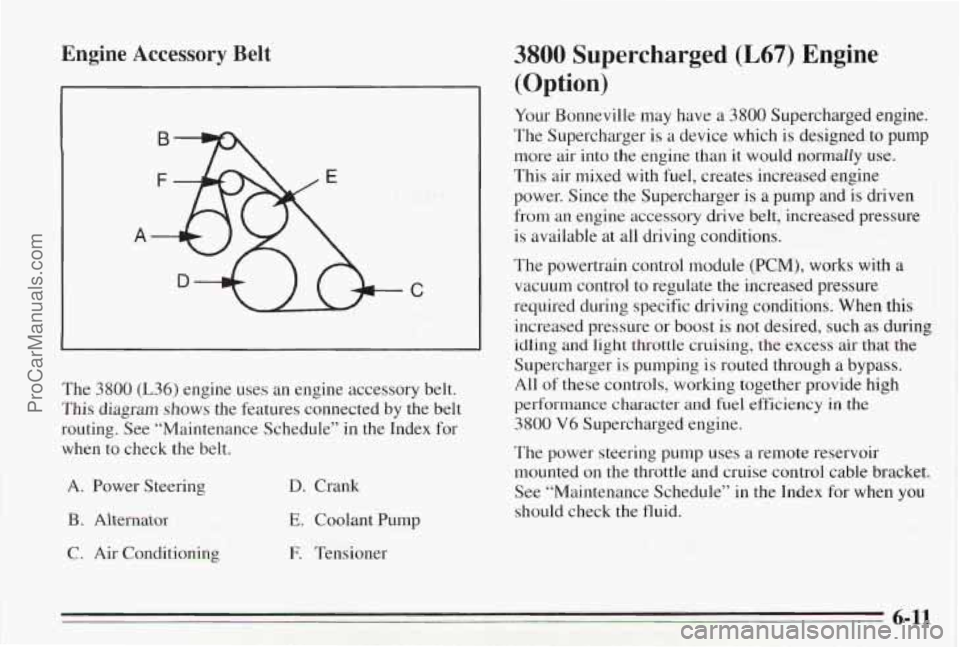
Engine Accessory Belt
A
C
The 3800 (L36) engine uses an engine accessory belt.
This diagram shows the features connected by the belt
routing. See “Maintenance Schedule” in the Index for
when to check the belt.
A. Power Steering
B . Alternator
C. Air Conditioning
D. Crank
E. Coolant Pump
E Tensioner
3800 Supercharged (L67) Engine
(Option)
Your Bonneville may have a 3800 Supercharged engine.
The Supercharger is
a device which is designed to pump
more air into the engine than it would normally
use.
This air mixed with fuel, creates increased engine
power. Since the Supercharger is a pump and is driven
from an engine accessory drive belt, increased pressure
is available at all driving conditions.
The powertrain control module
(PCM), works with a
vacuum control to regulate the increased pressure
required during specific driving conditions. When this
increased pressure or boost is not desired, such as during
idling
and light throttle cruising, the excess air that the
Supercharger is pumping is routed through a bypass.
All
of these controls, working together provide high
performance character
and fuel efficiency in the
3800 V6 Supercharged engine.
The power steering pump uses a remote reservoir
mounted on the throttle and cruise control cable bracket.
See “Maintenance Schedule”
in the Index for when you
should check the fluid.
6-11
ProCarManuals.com
Page 226 of 338
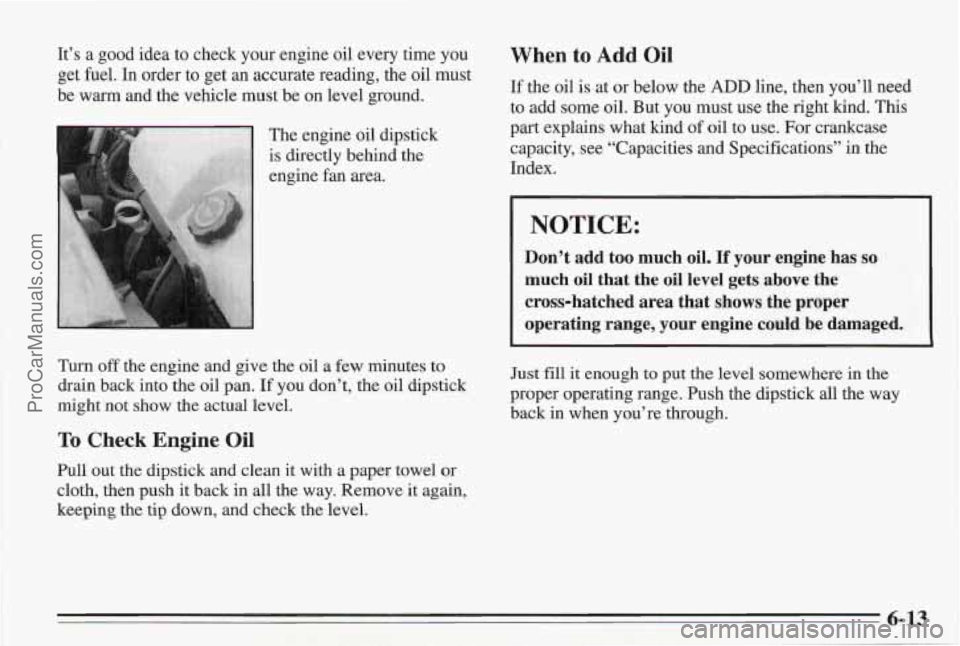
It’s a good idea to check your engine oil every time you
get fuel.
In order to get an accurate reading, the oil must
be
warm and the vehicle must be on level ground.
~ The engine oil dipstick
is directly behind the
i engine fan area.
Turn
off the engine and give the oil a few minutes to
drain back into the oil pan. If you don’t, the oil dipstick
might not show the actual level.
To Check Engine Oil
Pull out the dipstick and clean it with a paper towel or
cloth, then push it back in all the way. Remove it again,
keeping
the tip down, and check the level.
When to Add Oil
If the oil is at or below the ADD line, then you’ll need
to add some oil. But you must use the right kind. This
part explains what kind of oil to use.
For crankcase
capacity, see “Capacities and Specifications” in the
Index.
t
I NOTICE:
Don’t add too much oil. If your engine has so
much oil that the oil level gets above the
cross-hatched area that shows the proper
operating range, your engine could be damaged.
Just fill it enough to put the level somewhere in the
proper operating range. Push the dipstick
all the way
back in when you’re through.
ProCarManuals.com
Page 227 of 338
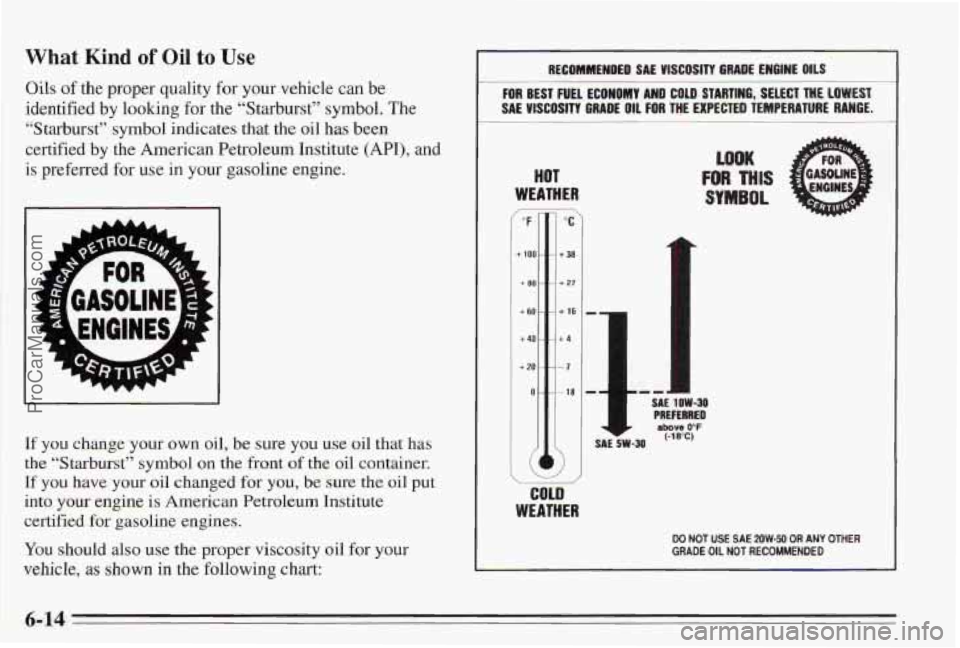
What Kind of Oil to Use
Oils of the proper quality for your vehicle can be
identified by looking for the “Starburst” symbol. The
“Starburst” symbol indicates that
the oil has been
certified by the American Petroleum Institute (API), and
is preferred for use in your gasoline engine.
**
L
t
t L
4
If you change your own oil, be sure you use oil that has
the “Starburst” symbol on the front of the oil container.
If you have your oil changed for you, be sure the oil put
into your engine is American Petroleum Institute
certified for gasoline engines.
You should also use
the proper viscosity oil for your
vehicle,
as shown in the following chart:
~
RECOMMENDED SAE VISCOSITY GRADE ENGINE OILS
FOR BEST FUEL ECONOMY AND COLD STARTINB, SELECT THE LOWEST
SAL VISCOSITY GRADE OIL FOR THE EXPECTED TEMPERATURE RANGE.
HOT
WEATHER 7
“C
+ 38
+ 27
+ 16
t4
-1
- 18
M
LOOK
FOR THIS 1
SYMBOL
I E ERRRED 1OW-30
mve 0°F (-1 8°C)
WEATHER
DO NOT USE SAE 2OW.50 OR ANY OTHER GRADE OIL NOT RECOMMENDED
6-14
ProCarManuals.com
Page 247 of 338
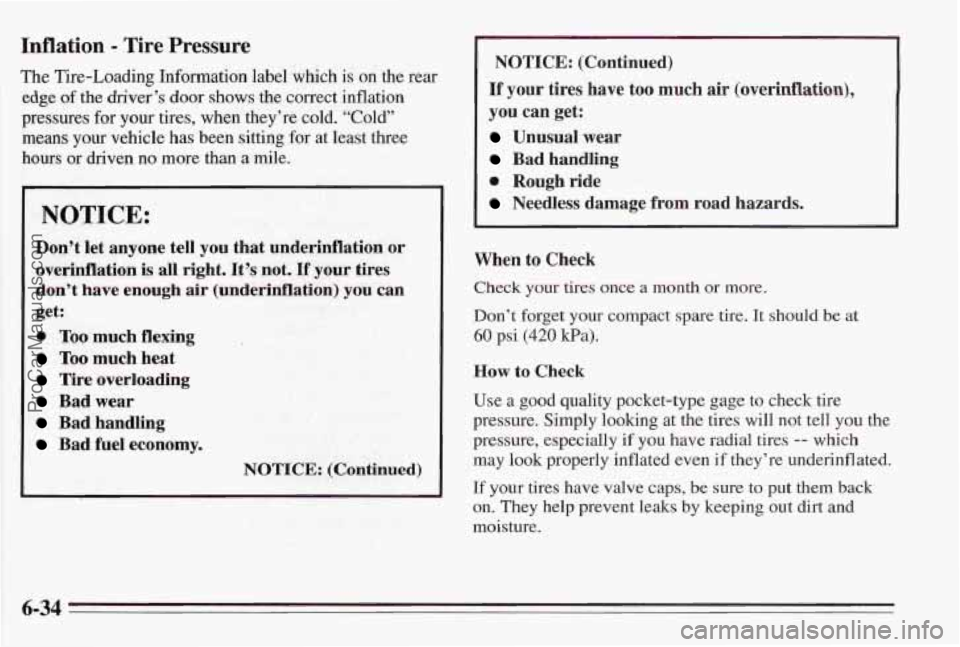
Inflation - Tire Pressure
The Tire-Loading Information label which is on the rear
edge
of the driver’s door shows the correct inflation
pressures for your tires, when they’re cold.
“Cold”
means your vehicle has been sitting for at least three
hours or driven no more than a mile.
NOTICE:
Don’t let anyone tell you that un’derinflation or
overinflation is all right. It’s not. If your tires
don’t
have enough air (underinflation] you can
get:
0 Too much flexing ’ i . ’:+?,,%
Too much heat
Tire overloading
Bad wear
Bad handling
Bad fuel economy.
. . . .> .’“’
NOTICE: (Continued)
NOTICE: (Continued)
If’ your tires have too much air (overinflation),
you can get:
Unusual wear
Bad handling
0 Rough ride
Needless damage from road hazards.
When to Check
Check your tires once a month or more.
Don’t forget your compact spare tire. It should be at
60 psi (420 Pa).
How to Check
Use a good quality pocket-type gage to check tire
pressure. Simply looking at the tires will not tell you the
pressure, especially if you have radial tires
-- which
may look properly inflated even if they’re underinflated.
If your tires have valve caps, be sure to put them back
on. They help prevent leaks by keeping
out dirt and
moisture.
6-34
ProCarManuals.com
Page 259 of 338
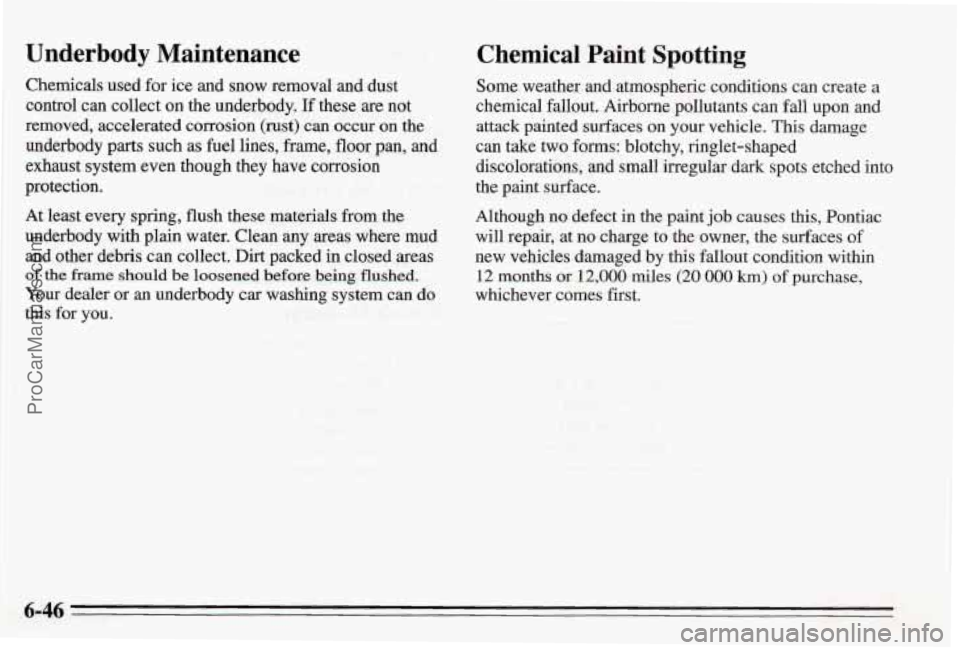
Underbody Maintenance
Chemicals used for ice and snow removal and dust
control can collect
on the underbody. If these are not
removed, accelerated corrosion
(rust) can occur on the
Underbody
parts such as fuel lines, kame, floor pan, and
exhaust system even though they have corrosion
protection.
At least
every spring, flush these materials from the
underbody with plain water. Clean any areas where mud
and other debris can collect. Dirt packed in closed areas
of the frame should be loosened before being flushed.
Your dealer or am underbody car washing system can do
this for you.
Chemical Paint Spotting
Some weather and atmospheric conditions can create a
chemical fallout. Airborne pollutants can
€dl upon and
attack painted surfaces
on your vehicle. This damage
can take two forms: blotchy, ringlet-shaped
discolorations,
and small irregular dark spots etched into
the paint surface.
Although no defect in the
paint job causes this, Pontiac
will repair, at
no charge to the owner, the surfaces of
new vehicles damaged
by this fallout condition within
12 months or 12,000 des (20 000 km) of purchase,
whichever comes first.
6-46
ProCarManuals.com
Page 265 of 338
Right Side Fuse Panel: Additional fuses are located in
the relay center, on the far right side, below the
instrument panel.
You must remove the sound insulator
on the right side
of the passenger foot well to replace
these fuses.
Replacing these fuses
is difficult. We recommend that
you see your dealer
if you need one replaced.
Position Circuitry
1 Door Locks
2 Power Antenna, Lock Switch
3 Horns
4 Not Used
5 Cruise Control, Misc. Engine
Controls
6 Fuel Pump
7 Injectors
8 Electronic Control Module,
9 Not Used
10 Not Used
11 A/C Programmer PASS-Key
@I1
12 Not Used
POSITIONS
r---------- I FUSE I I POSITIONS I
6-52
ProCarManuals.com